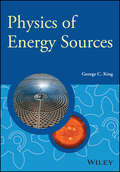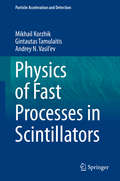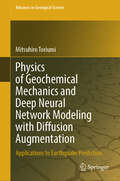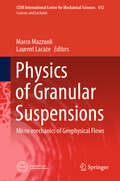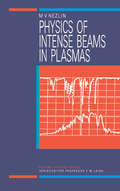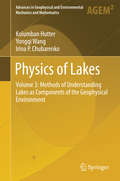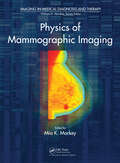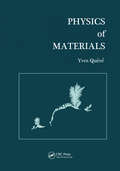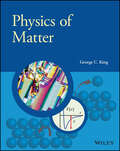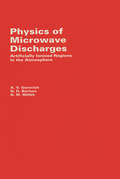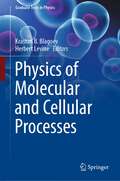- Table View
- List View
Physics of Electronic Ceramics, (2 Part)
by L. L. HenchThis book includes papers, presented at a conference held at the University of Florida in 1969, on aspects of the technology of electronic ceramics in terms of the underlying science upon which the technology depends. It is intended for users of electronic ceramics and teachers in this field.
Physics of Electronic Materials: Principles and Applications
by Jørgen RammerAdopting a uniquely pedagogical approach, this comprehensive textbook on the quantum mechanics of semiconductor materials and devices focuses on the materials, components and devices themselves whilst incorporating a substantial amount of fundamental physics related to condensed matter theory and quantum mechanics. Written primarily for advanced undergraduate students in physics and engineering, this book can also be used as a supporting text for introductory quantum mechanics courses, and will be of interest to anyone interested in how electronic devices function at a fundamental level. Complete with numerous exercises, and with all the necessary mathematics and physics included in appendices, this book guides the reader seamlessly through the principles of quantum mechanics and the quantum theory of metals and semiconductors, before describing in detail how devices are exploited within electric circuits and in the hardware of computers, for example as amplifiers, switches and transistors. Includes numerous exercises throughout, allowing the reader to observe theoretical concepts put to practical use and to learn about the important technological applications of quantum mechanics. Assumes only basic mathematical skills, and includes the elementary physics needed for understanding the content of the chapters within the appendices. Focuses on the materials, components and devices themselves whilst also incorporating a considerable amount of fundamental physics related to condensed matter theory and quantum mechanics.
Physics of Energy Sources
by George C. KingPhysics of Energy Sourcesprovides readers with a balanced presentation of the fundamental physics needed to understand and analyze conventional and renewable energy sources including nuclear, solar, wind and water power. It also presents various ways in which energy can be stored for future use. The book is an informative and authoritative text for students in the physical sciences and engineering and is based on a lecture course given regularly by the author. With the ever increasing demand for sustainable, environmentally-friendly and reliable sources of energy, the need for scientists and engineers equipped to tackle the challenges of developing and improving upon commercially viable energy sources has never been more urgent. By focusing on the physical principles governing energy production, storage, and transmission, this book provides readers with a solid foundation in the science and technology of energy sources. Physics of Energy Sources features include: Analyses of conventional and renewable energy sources in terms of underlying physical principles Integrated application of a wide range of physics, from classical to quantum physics Coverage of nuclear, wind, wave, tidal, hydroelectric, geothermal and solar power, including many practical systems Consideration of efficiency for power production as well as energy storage and transportation Consideration of key environmental issues Worked examples in text, and problems & solutions to encourage understanding Derivation of formulae with a minimum of mathematical complexity
Physics of Everyday Phenomena (Eighth Edition)
by W. Thomas Griffith Juliet W. BrosingThe Physics of Everyday Phenomena, Eighth Edition, introduces students to the basic concepts of physics using examples of common occurrences in everyday life. Intended for use in a one-semester or two-semester course in conceptual physics, this book is written in a narrative style, frequently using questions designed to draw the reader into a dialogue about the ideas of physics. This inclusive style allows the book to be used by anyone interested in exploring the nature of physics and explanations of everyday physical phenomena. Beginning students will benefit from the large number of student aids and the reduced math content. Professors will appreciate the organization of the material and the wealth of pedagogical tools.
Physics of Fast Processes in Scintillators (Particle Acceleration and Detection)
by Mikhail Korzhik Gintautas Tamulaitis Andrey N. Vasil'evThis book presents the current advances in understanding of the fast excitation transfer processes in inorganic scintillation materials, the discovery of new materials exhibiting excellent time resolution, and the results on the evaluation of timing limits for scintillation detectors. The book considers in-depth basic principles of primary processes in energy relaxation, which play a key role in creating scintillating centers to meet a growing demand for knowledge to develop new materials combining high energy and time resolutions. The rate of relaxation varies. However, the goal is to make it extremely fast, occurring within the ps domain or even shorter. The book focuses on fast processes in scintillation materials. This approach enables in-depth understanding of fundamental processes in scintillation and supports the efforts to push the time resolution of scintillation detectors towards 10 ps target. Sophisticated theoretical and advanced experimental research conducted in the last decade is reviewed. Engineering and control of the energy transfer processes in the scintillation materials are addressed. The new era in development of instrumentation for detection of ionizing radiation in high- energy physics experiments, medical imaging and industrial applications is introduced. This book reviews modern trends in the description of the scintillation build up processes in inorganic materials, transient phenomena, and engineering of the scintillation properties. It also provides reliable background of scientific and educational information to stimulate new ideas for readers to implement in their research and engineering. The book is aimed at providing a coherent updated background of scientific and instructive information to stimulate new ideas for readers in their research and engineering.
Physics of Fluids (UNITEXT for Physics)
by Roberto A. Capuzzo DolcettaThis book is exceptional in providing an up-to-date, but compact, introduction to the field of hydrodynamics and fluid dynamics that is both sufficiently comprehensive and easy to read. It covers all the elements of compressible and incompressible fluid dynamics, from the basic concepts through to the constituent equations and their applications. Fluid flows in different environments are thoroughly discussed, and specific aspects such as dissipation, turbulence, shock waves, and blast waves receive detailed attention. The book contains many exercises and draws attention to numerical solutions to specific problems. The book is ideal for undergraduate and graduate students and young researchers in physics, astrophysics, mathematics (pure and applied), and engineering. As this book is intended for a wide audience, the mathematical prerequisites are kept to a low level.
Physics of Fluids in Microgravity (Earth Space Institute Book Series)
by R. MontiIn a microgravity experiment, the conditions prevalent in fluid phases can be substantially different from those on the ground and can be exploited to improve different processes. Fluid physics research in microgravity is important for the advancement of all microgravity scients: life, material, and engineering. Space flight provides a uniqu
Physics of Fully Ionized Gases: Second Revised Edition
by Lyman Spitzer Jr.This classic graduate-level volume was the first general but simple introduction to the fields of plasma and fusion research. Since its original publication in 1956, it has served as a valuable reference. Designed for those who have had an introductory course in theoretical physics but are otherwise unacquainted with the detailed kinetic theory of gases, it chiefly emphasizes macroscopic equations and their consequences.The contents are restricted to topics offering a theoretical understanding of plasma and fusion research. Subjects include the motion of a particle, macroscopic behavior of a plasma, waves in a plasma, equilibria and their stability, and encounters between changed particles. A helpful appendix offers background on the Boltzmann equation.Author Lyman Spitzer, Jr., was the first to propose the idea of placing a large telescope in space, and he was the driving force behind the development of the Hubble Space Telescope. Founder and director of Princeton's Plasma Physics Laboratory, a pioneering program in controlled thermonuclear research, Spitzer taught and inspired a generation of plasma physicists.
Physics of Gas-Liquid Flows
by Thomas J. HanrattyPresenting tools for understanding the behaviour of gas-liquid flows based on the ways large scale behaviour relates to small scale interactions, this text is ideal for engineers seeking to enhance the safety and efficiency of natural gas pipelines, water-cooled nuclear reactors, absorbers, distillation columns and gas lift pumps. The review of advanced concepts in fluid mechanics enables both graduate students and practising engineers to tackle the scientific literature and engage in advanced research. It focuses on gas-liquid flow in pipes as a simple system with meaningful experimental data. This unified theory develops design equations for predicting drop size, frictional pressure losses and slug frequency, which can be used to determine flow regimes, the effects of pipe diameter, liquid viscosity and gas density. It describes the effect of wavy boundaries and temporal oscillations on turbulent flows, and explains transition between phases, which is key to understanding the behaviour of gas-liquid flows.
Physics of Geochemical Mechanics and Deep Neural Network Modeling with Diffusion Augmentation: Applications to Earthquake Prediction (Advances in Geological Science)
by Mitsuhiro ToriumiThis book provides a new data augmentation method based on the local stochastic distribution patterns in natural time series data of global and regional seismicity rates and their correlated seismicity rates. The augmentation procedure is called the diffusion – denoising augmentation method from the local Gaussian distribution of segmented data of long time series. This method makes it possible to apply the deep machine learning necessary to neural network prediction of rare large earthquakes in the global and regional earth system.The book presents the physical background of the processes showing the development of characteristic features in the global and regional correlated seismicity dynamics, which are manifested by the successive time series of 1990–2023. Physical processes of the correlated global seismicity change and the earth’s rotation, fluctuation of plate motion, and the earth’s ellipsoid ratio (C20 of satellite gravity change) are proposed in this book. The equivalency between Gaussian seismicity network dynamics and the minimal nonlinear dynamics model of correlated seismicity rates is also provided. In addition, the book contains simulated models of the shear crack jog wave, precipitation of minerals in the jog, and jog accumulation inducing shear crack propagation which leads to earthquakes in the plate boundary rocks under permeable fluid flow.
Physics of Granular Suspensions: Micro-mechanics of Geophysical Flows (CISM International Centre for Mechanical Sciences #612)
by Marco Mazzuoli Laurent LacazeThis book provides graduate students and scientists with fundamental knowledge on the mechanics of granular suspensions as well as on the mathematical and numerical techniques that can be adopted to investigate geophysical flows. To this end, three formidably complex problems (sediment transport, flow-like landslide inception, and gravity currents) are considered. The reader will find a thorough combination of elements of fluid and solid mechanics, rheology, geotechnics, geomorphology, civil, and coastal engineering. The first part of the book introduces the problem of granular suspensions from the mathematical viewpoint, focusing on issues that characterise geophysical flows such as turbulence, the effects of inter-particle contacts, and strong velocity gradients. In the second part, different models that were successfully used to investigate the mechanics of granular suspensions in environmental flows are presented.
Physics of Gravitational Waves: Sources and Detection Methods (SpringerBriefs in Physics)
by Arun Kenath Chandra SivaramThis book provides a concise introduction to the physics of gravitational waves. It is aimed at graduate-level students and PhD scholars. Ever since the discovery of gravitational waves in 2016, gravitational wave astronomy has been adding to our understanding of the universe.Gravitational waves have been detected in the past few years from several transient events such as merging stellar-mass black holes, binary neutron stars, etc. These waves have frequencies in a band ranging from a few hundred hertz to around a kilohertz to which LIGO type instruments are sensitive. LISA will be sensitive to much lower range of frequencies from SMBH mergers. Apart from these cataclysmic burst events, there are innumerable sources of radiation which are continuously emitting gravitational waves of all frequencies. These include a whole mass range of compact binary and isolated compact objects and close planetary stellar entities. This book discusses the gravitational wave background produced in typical frequency ranges from such sources emitting over a Hubble time and the fluctuations in the h values measured in the usual devices. Also discussed are the high-frequency thermal background gravitational radiation from hot stellar interiors and newly formed compact objects. The reader will also learn how gravitational waves provide a testing tool for various theories of gravity, i.e. general relativity and extended theories of gravity, and will be the definitive test for general relativity.
Physics of Intense Beams in Plasmas
by M.V NezlinPhysics of Intense Beams in Plasmas is a comprehensive description of the interaction between extremely intense particle beams and plasmas. The emphasis is on experimental beam-plasma physics, but the necessary theory is also explained-much of which is innovative and original. Central to the book is the discussion of beam instabilities, emphasizing their hydrodynamic nature.
Physics of Josephson Diodes Formed from 1T-Transition Metal Dichalcogenides (Springer Theses)
by Pranava Keerthi SivakumarThis book provides a clear and lucid introduction to the field of non-reciprocal supercurrent transport in Josephson junctions, particularly the Josephson diode effect in junctions fabricated from mechanically exfoliated transition metal dichalcogenides and its microscopic mechanism. Superconducting materials that display a non-reciprocity in their critical current, namely a supercurrent diode effect (SDE), and Josephson junctions (JJs) that display a Josephson diode effect (JDE) have recently been discovered just a few years ago. These phenomena have attracted much attention for their potential in creating energy-efficient superconducting electronics. The SDE was discovered for the first time only in 2020 and the JDE shortly afterwards. JJs are a critical element of many superconducting devices and, in particular, superconducting qubits that are under intense study for the development of quantum computers. In order to make use of devices that display a JDE, a detailed and comprehensive understanding of the physical origin or origins of this effect is essential, which is the main topic of this dissertation. In addition to the published results, the dissertation contains detailed information on the basic theoretical aspects of superconductivity, Josephson junctions, and the experimental methods that are necessary to achieve these results, which is suitable for undergraduate and graduate students or any reader with knowledge on basic condensed matter physics.
Physics of Lakes
by Irina P. Chubarenko Kolumban Hutter Yongqi WangThis first volume in the treatise on the Physics of Lakes deals with the formulation of the mathematical and physical background. A large number of lakes on Earth are described, presenting their morphology as well as the causes of their response to the driving environment. Because the physics of lakes cannot be described without the language used in mathematics, these subjects are introduced first by using the simplest approach and with utmost care, assuming only a limited college knowledge of classical Newtonian physics, and continues with increasing complexity and elegance, starting with the fundamental equations of Lake Hydrodynamics in the form of 'primitive equations' and leading to a detailed treatment of angular momentum and vorticity. Following the presentation of these fundamentals turbulence modeling is introduced with Reynolds, Favre and other non-ergodic filters. The derivation of averaged field equations is presented with different closure schemes, including the k-ε model for a Boussinesq fluid and early anisotropic closure schemes. This is followed by expositions of surface gravity waves without rotation and an analysis of the role played by the distribution of mass within water bodies on the Earth, leading to a study of internal waves. The vertical structure of wind-induced currents in homogeneous and stratified waters and the Ekman theory and some of its extensions close this first volume of Physics of Lakes. The last chapter collects formulas for the phenomenological coefficients of water.
Physics of Liquid Matter (Soft and Biological Matter)
by Paola Gallo Mauro RovereThis book offers a didactic and a self-contained treatment of the physics of liquid and flowing matter with a statistical mechanics approach. Experimental and theoretical methods that were developed to study fluids are now frequently applied to a number of more complex systems generically referred to as soft matter. As for simple liquids, also for complex fluids it is important to understand how their macroscopic behavior is determined by the interactions between the component units. Moreover, in recent years new and relevant insights have emerged from the study of anomalous phases and metastable states of matter. In addition to the traditional topics concerning fluids in normal conditions, the authors of this book discuss recent developments in the field of disordered systems in condensed and soft matter. In particular they emphasize computer simulation techniques that are used in the study of soft matter and the theories and study of slow glassy dynamics. For these reasons the book includes a specific chapter about metastability, supercooled liquids and glass transition.The book is written for graduate students and active researchers in the field.
Physics of Liquid Matter: Modern Problems
by Nikolai Lebovka Leonid BulavinThese proceedings comprise invited and contributed papers presented at PLMMP-2014, addressing modern problems in the fields of liquids, solutions and confined systems, critical phenomena, as well as colloidal and biological systems. The book focuses on state-of-the-art developments in contemporary physics of liquid matter. The papers presented here are organized into four parts: (i) structure of liquids in confined systems, (ii) phase transitions, supercritical liquids and glasses, (iii) colloids, and (iv) medical and biological aspects and cover the most recent developments in the broader field of liquid state including interdisciplinary problems.
Physics of Magnetic Flux Tubes
by Margarita RyutovaThis book is the first account of the physics of magnetic flux tubes from their fundamental properties to collective phenomena in an ensembles of flux tubes. The physics of magnetic flux tubes is absolutely vital for understanding fundamental physical processes in the solar atmosphere shaped and governed by magnetic fields. High-resolution and high cadence observations from recent space and ground-based instruments taken simultaneously at different heights and temperatures not only show the ubiquity of filamentary structure formation but also allow to study how various events are interconnected by system of magnetic flux tubes. The book covers both theory and observations. Theoretical models presented in analytical and phenomenological forms are tailored for practical applications. These are welded with state-of-the-art observations from early decisive ones to the most recent data that open a new phase-space for exploring the Sun and sun-like stars. Concept of magnetic flux tubes is central to various magnetized media ranging from laboratory plasma and Earth's magnetosphere to planetary, stellar and galactic environments The book is a valuable resource for graduate students, solar physicists, astronomers, laboratory and space plasma physicists, geophysicists, and specialists in gas- and hydrodynamics.
Physics of Magnetic Flux Tubes (Astrophysics and Space Science Library #417)
by Margarita RyutovaThis book presents the physics of magnetic flux tubes, including their fundamental properties and collective phenomena in an ensemble of flux tubes. The physics of magnetic flux tubes is vital for understanding fundamental processes in the solar atmosphere that are shaped and governed by magnetic fields. The concept of magnetic flux tubes is also central to various magnetized media ranging from laboratory plasma and Earth's magnetosphere to planetary, stellar and galactic environments.The book covers both theory and observations. Theoretical models presented in analytical and phenomenological forms that are tailored to practical applications. These are welded together with empirical data extending from the early pioneering observations to the most recent state-of-the-art data.This new edition of the book is updated and contains a significant amount of new material throughout as well as four new chapters and 48 problems with solutions. Most problems make use of original papers containing fundamental results. This way, the original paper, often based on complex theory, turns into a convenient tool for practical use and quantitative analysis.
Physics of Mammographic Imaging (Imaging in Medical Diagnosis and Therapy)
by Mia K. MarkeyDue to the increasing number of digital mammograms and the advent of new kinds of three-dimensional x-ray and other forms of medical imaging, mammography is undergoing a dramatic change. To meet their responsibilities, medical physicists must constantly renew their knowledge of advances in medical imaging or radiation therapy, and must be prepared
Physics of Materials
by Yves QuereFew areas of science are as interdisciplinary as materials science. Chemistry, physics, mechanical engineering, and mathematics each play a part within it. The role of physics is to describe the objects, effects and phenomena at different scales (micro-, meso-, and macroscopic) as precisely as possible. Physics of Materials addresses this description at the elementary level. Based on an undergraduate level course taught at the Ecole Polytechnique, France, the main emphasis is on the conduction related phenomena (electronic properties) and the plastic behavior (ionic properties) of materials, such as metals and alloys, semiconductors, and ceramics. It assumes a basic grounding in statistical physics, quantum mechanics and elasticity but does not require prior knowledge of solid-state physics, to which it will serve as a useful introduction. The presentation of the course is followed by several examination problems, with solutions, which cover various specific applications of the general concepts and which will enable readers to test their understanding of these concepts.
Physics of Matter (Manchester Physics Series)
by George C. KingPhysics of Matter First year core course introductory textbook on the nature of matter that puts the physics before mathematical description Physics of Matter is an introductory textbook on the nature of matter, based on a description of gases, liquids, liquid crystals and solids in terms of the forces that bind atoms and molecules together and their thermal motion, that discusses the relationship of these phases of matter to heat and the basic principles of thermodynamics. Physics of Matter is unique in its coverage of material and includes topics that have become important in recent times such as graphene and liquid crystals. Material in the book is reinforced by numerous worked examples in the text and problems and solutions at the end of each chapter, the latter ranging in difficulty from simple exercises to challenging problems. The emphasis is on clarity of exposition and explanation, putting the physics before the mathematical with general physical principles that can be more widely applied being stressed. Published in the Manchester Physics Series, which has the reputation of providing insight, depth, and often details on a subject not found in other textbooks, sample topics covered in Physics of Matter include: Characteristics of atoms (sizes and masses) and Avogadro’s number, the forces that bind atoms and molecules together, and the Lennard-Jones potential Thermal energy, temperature, and the Boltzmann law, covering equations of state, the ideal gas equation, and equipartition of energy Kinetic theory and transport properties of gases, covering molecular collisions, pressure of an ideal gas, the mean free path and diffusion Real gases, including Van der Waals equation of state, virial expansion, critical constants, and heat capacities Reversible processes, entropy, the Carnot cycle, the thermodynamic fundamental relationship, and Gibbs free energy Solids, including crystal structure, elastic moduli and Einstein’s model of heat capacity Liquids, including liquid flow and Bernoulli’s equation, and liquid crystals Physics of Matter is a valuable learning resource for first- and second-year students in physics, chemistry, and engineering, as well as those in adjacent science courses including environmental and biological sciences. The book is written for the subject traditionally called “Properties of Matter.”
Physics of Microwave Discharges: Artificially Ionized Regions in the Atmosphere
by A GurevichA comprehensive and unique account of the creation of artificially ionized layers in the middle and upper atmosphere, using powerful radio waves. Major physical mechanisms associated with the formation of the ionized region are studied in detail. The main part of the author's research is devoted to problems associated with the breakdown mechanisms for radio frequency discharges in air. A special chapter deals with breakdown in intersecting pulsed beams and the effects of recombination, diffusion and atmospheric winds on the stability of the structure. The kinetics of the plasma produced are also described. The authors examine possibilities of inducing changes in the chemical composition of the upper atmosphere by means of radio frequence heating, with promising effects on the concentration of constituents such as ozone. The feasibility of using this phenomenon for; ozone healing - in connection with the ozone holes in the polar regions is investigated. The text is a timely treatment of key topics in the field of ionospheric modification.
Physics of Molecular and Cellular Processes (Graduate Texts in Physics)
by Krastan B. Blagoev Herbert LevineThis is a graduate-level introduction to quantitative concepts and methods in the science of living systems. It relies on a systems approach for understanding the physical principles operating in biology. Physical phenomena are treated at the appropriate spatio-temporal scale and phenomenological equations are used in order to reflect the system of interest. Biological details enter to the degree necessary for understanding specific processes, but in many cases the approach is not reductionist. This is in line with the approach taken by physics to many other complex systems.The book bridges the gap between graduate students’ general physics courses and research papers published in professional journals. It gives students the foundations needed for independent research in biological physics and for working in collaborations aimed at quantitative biology and biomedical research. Also included are modern mathematical and theoretical physics methods, giving the student a broad knowledge of tools that can shed light on the sophisticated mechanisms brought forth by evolution in biological systems. The content covers many aspects that have been the focus of active research over the past twenty years, reflecting the authors' experience as leading researchers and teachers in this field.
Physics of Nanostructured Solid State Devices
by Supriyo BandyopadhyayPhysics of Nanostructured Solid State Devices introduces readers to theories and concepts such as semi-classical and quantum mechanical descriptions of electron transport, methods for calculations of band structures in solids with applications in calculation of optical constants, and other advanced concepts. The information presented here will equip readers with the necessary tools to carry out cutting edge research in modern solid state nanodevices.


